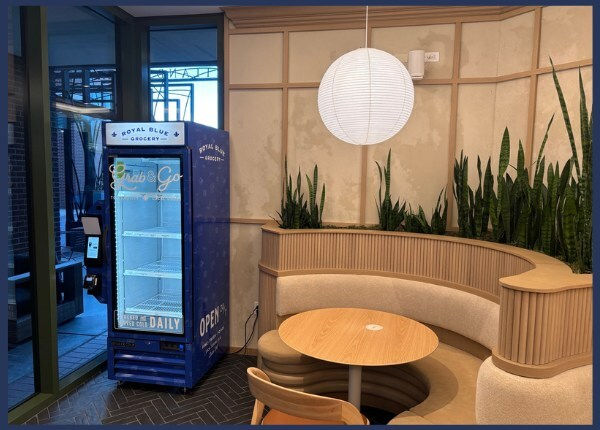Refreshment focuses on the water dispenser/cooler, office coffee service and vending sectors, while also taking an in-depth look into products for vending from bottled water and drinks, to snacks and confectionery. It also focuses on hydration, health and wellness, new technologies and environmental and social responsibility issues.
Hospitality
Research
Coffee & tea

With evolving consumer needs and a growing demand for high-quality beverage machines, the rise of IoT in automatic dispensing has enhanced functionality and improved user experience. Refreshment spoke to several key players in the water dispensing and filtration sector to gather their thoughts on the future of IoT in the industry.
For many, the emergence of IoT and AI represent a force for good – designed to improve efficiency and sustainability. Arguably one of the most important innovations in the sector in recent years, IoT has transformed the water dispensing and filtration landscape.
Italian manufacturer of water dispensers Zerica was a pioneer in bringing IoT to the watercooler market, as managing director Antonio Zerilli told Refreshment.
“We saw the potential to enhance not only the convenience of our products but also their efficiency, sustainability and the user experience. Our IoT-enabled watercoolers allow for remote monitoring, predictive maintenance and data driven insights into water usage, making them smarter, more reliable and environmentally conscious. It’s not just about dispensing water anymore – it’s about using technology to offer real solutions to everyday needs.”
Enabling new ideas in water dispensing has been a positive change brought about by IoT, said Emma Redford, marketing director at H2O Direct, a water filtration provider for coffee, vending and point-of-use (POU) watercoolers.
“IoT has enhanced water machine ranges to enable them to communicate with smart monitoring systems,” she explained. “This allows operators to remotely monitor factors like water flow, cups dispensed, CO2 consumption, filter status and more in order to accurately predict when maintenance will need to be carried out.”
Sustainability
Another positive effect of the advent of IoT in water dispensing is the potential for businesses to reduce their environmental footprint. Redford believes that “IoT will be even more essential in the future to make machines as ‘green’ as possible”.
For example, she highlights the possibilities of monitoring usage to enable “power down times” to save power consumption when machines are not in use.
Zerica’s Zerilli agreed, adding that: “We believe that IoT will enable more personalised and sustainable water solutions. Users will be able to track and optimise their water usage, while businesses will benefit from systems that reduce operational costs and environmental impact. The future of IoT in this space is about creating smarter, more efficient water dispensers that not only meet consumer needs but also contribute to global sustainability goals.”
Harnessing 5G
5G technology is the successor to 4G, and with its higher bandwidth, it can deliver faster connectivity speeds and connect more devices. As 5G coverage expands, it is poised to open up new possibilities within IoT and machine-to-machine communication.
According to Patrick Aigeldinger, director of product management at ultra-violet (UV) disinfectant technology expert Crystal IS, the roll-out of 5G is good news for the water filtration sector.
“IoT can optimise energy consumption by adjusting cooling and heating based on usage patterns,” he explained. “For mobile treatment systems, this can optimise battery usage – and also allow the systems to take better advantage of periodic treatment techniques like solid state LEDs to reduce energy use.”
Zerica’s Zerilli believes that the real advantage of 5G lies in its “low latency and reliability,” ensuring that data from IoT-enabled watercoolers is transmitted instantly and securely. “This can improve the responsiveness of our systems, particularly for remote monitoring and real-time adjustments,” he said.
“Additionally, as 5G networks expand, the increased reliability and connectivity will help ensure that even in areas with less robust infrastructure, our devices can maintain stable and consistent communication. So while the data requirements are low, the improved network performance will still enhance the user experience and help future-proof our solutions.”
H2O’s Redford added: “The growth of 5G technology will help manufacturers to connect their machines to better data transfer systems. “This is one of the issues throughout the industry for installing data transmission from customers’ premises around the UK.”
However, she warned that some areas are still “in the dark” with 5G, meaning that using IoT monitoring can be challenging for customers and locations that do not have WIFI.

AI integration
Artificial intelligence (AI) and IoT, used together, can offer awareness and decision-making to further improve processes.
“Combining IoT and AI has great potential in the water dispensing sector,” stated Zerica’s Zerilli. “IoT enables us to collect valuable data, while AI can analyse and learn from that data to drive smarter decisions. This combination opens up exciting possibilities to improve efficiency, sustainability and user experience.”
It also allows for more advanced smart scheduling and optimised power usage, according to Crystal IS’s Aigeldinger. “Combining IoT and AI…can enable systems to significantly extend maintenance cycles by predicting maintenance requirements based on actual usage patterns,” he said. “This means that products can automatically enter power-saving modes during low-usage periods to extend total system life.”
IoT for production
In addition to service and maintenance applications, IoT has a place within product development. The use of digital twins, for example, involves a virtual model of a real-world object, system or process that can be used for simulation and testing.
Zerica uses virtual models of its physical products to monitor performance, simulate various scenarios and make data-driven improvements. Zerilli told Refreshment that this approach enables the manufacturer to test new features, optimise performance and address potential issues before they arise.
“In addition, we apply IoT to conduct precise, real-time control over our entire manufacturing process,” Zerilli continued. “By integrating IoT into production, we ensure that every step is closely monitored for quality, efficiency and accuracy.”
Building the future
IoT technology is already firmly embedded in the water dispense sector – and most industry players believe it is here to stay.
“Real-time access to system data has become the expectation for consumers, as smartwatches and homes have become standard,” said Crystal IS’s Aigeldinger. “Having access to this data in their water treatment systems allows [users] to easily access data on component replacements or repairs needed to ensure the system is operating as needed.”
Zerica’s Zerilli firmly believes IoT will be essential for water dispensing in the future. “As we look ahead, the demand for smarter, more efficient systems is only growing,” he pointed out. “IoT enables real-time data collection and insights that weren’t possible before, allowing us to manage resources more responsibly and improve user experience.”
“As IoT technology continues to evolve, we expect to see even more intelligent, connected systems that go beyond simple water dispensing. The focus will shift towards greater automation, predictive maintenance and real-time monitoring of water quality and consumption patterns, all driven by data from IoT devices.”
H2O Direct’s Redford highlighted “high-volume, outside-type” fountain and bottle refill stations as probable future beneficiaries of IoT. “These units will require increasing data monitoring in the field,” she said. “This will enhance the way water dispensing works for the general public in the future.”
The benefits of IoT are manifold, encompassing convenience, performance, cost-efficiency and sustainability. Looking ahead, it’s clear that IoT will not just be an optional feature, but will become the standard for the water dispense industry.
#Refreshmentmagazine
.png)











